0 March. Seymour Papert and body programming training (and unconscious)
Hi, Habr!
Together with the company Edison we start the spring marathon of publications.
I will try to get to the primary sources of IT-technologies, to understand how they thought and what concepts were in the minds of the pioneers, what they dreamed about, how they saw the world of the future. Why did you think “computer”, “network”, “hypertext”, “intelligence amplifiers”, “collective problem solving system”, what meaning did they put into these concepts, what tools they wanted to achieve a result.
')
I hope that these materials will serve as an inspiration for those who are wondering how to go “from Zero to Unit” (to create something that had never happened before). I would like IT and “programming” to stop being just “coding for the sake of dough”, and recall that they were conceived as a lever to change themethods of warfare, education, a way of working together, thinking and communication, as an attempt to solve world problems and answer facing humanity. Something like this.
Today celebrates its 22th birthday a man who was born in 1928 (88 astronomical years).
Seymour Papert is an outstanding mathematician, programmer, psychologist and teacher. One of the founders of the theory of artificial intelligence, the creator of Logo.
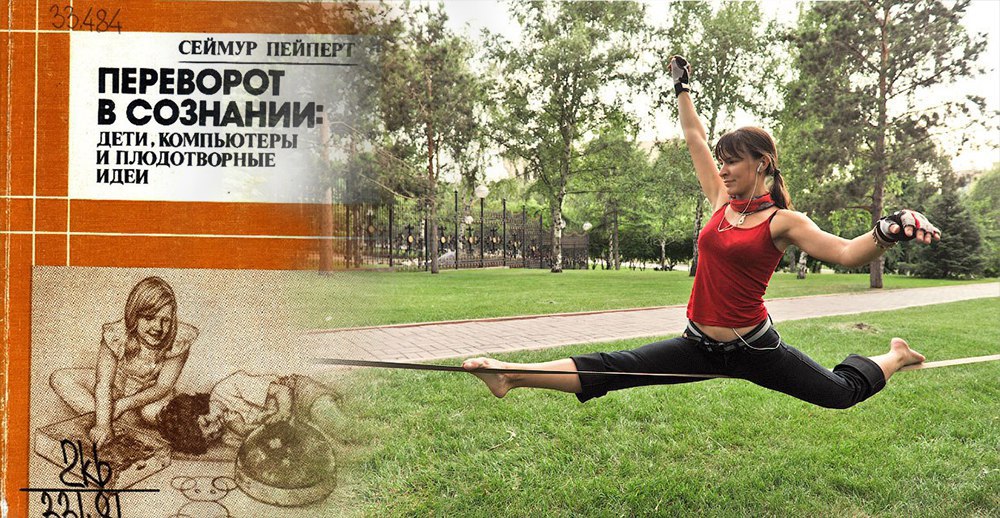
I have a rule. If something makes itself felt from three independent sources authoritative for me, then it is worth paying close attention to it.
The first time about Seymour Papert I heard a year ago in the hackspace from shamrin , he read his book in English and I was interested in his thoughts about juggling and programming, as well as the basic logical concepts formed in the brain of children.
A little later, I came to visit FISCHERTECHNIK , and I saw this book on the shelf, asked to read it for a month. I read avidly and realized that I had to buy the same for myself.
Half a year ago, I attended a presentation by David Yang , where he, responding to a question from the audience about whether his school has sponsors not from Armenia, mentioned Seymour Papert (it seems that only Jan and I in the audience knew who this was).
Today is the time to write about the author, about the book and about strong ideas. As well as explaining what has to do with juggling, stilts and slackline.
(and if you programmed on LOGO, then you will definitely be under the cat)
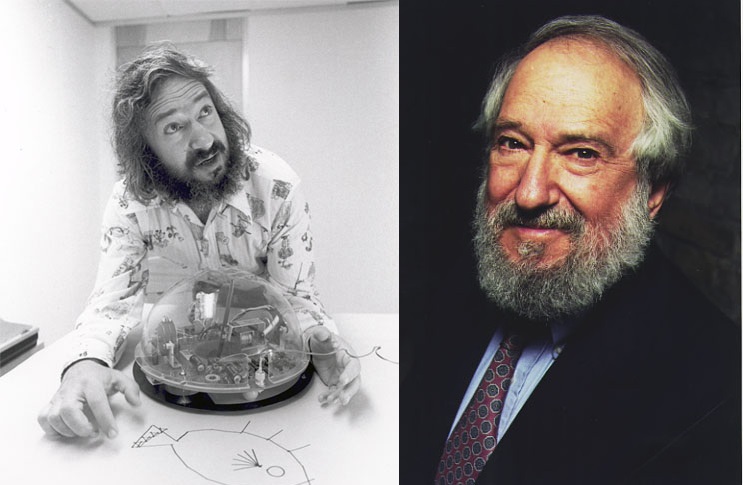
Like Ilon Musk, he was born in Pretoria, in Africa.
He studied at the University of Cambridge from 1954 to 1958, at which time he participated in the activities of the Trotskyist circle around the revolutionary socialist publication Socialist Review.
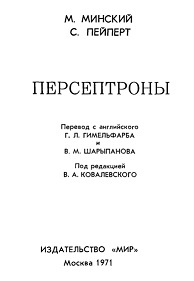
In the early 1960s, Dr. Papert came to the Massachusetts Institute of Technology (MIT), where, together with Marvin Minsky, he founded the Artificial Intelligence Laboratory and in 1970 published his book Perceptrons in collaboration with him. In 1972, Minsky and Papert also wrote the book Artificial Intelligence.
At MIT, Papert created the Epistemology and Learning Research Group at the MIT Architecture Machine Group, which soon became the legendary MIT Media Lab. Here he developed a learning theory called constructionism based on the works of Jean Piaget , with whom Papert worked side by side from 1958 to 1963. Piaget responded: "No one understands my ideas as good as Papert."
In 1988, Papert was named LEGO-Professor of Educational Research, and a department was created specifically for him.
His educational activities have received numerous awards, including the Marconi International Award (for outstanding contributions to communication technology), an award from the Publishers Association for Mathematical Software, and the Smithsonian Computer World Award for leadership in learning.
Papert came to Russia several times, visited Moscow and St. Petersburg (for the first time in 2001 or in the early 1990s, the last time in May 2005), addressed teachers and administrators of educational institutions.
Ershov in his article “Programming - second literacy” refers to Papert.
Logo (LOGO) is a high-level programming language developed in 1967 by Seymour Paperpt and Id Harel for educational purposes to teach preschool and primary school children the basic concepts of programming (recursion, extensibility, etc.). Logo also provides an environment in which children can develop their reasoning and problem solving skills. In essence, the logo language is an adaptation of the Lisp language (some even call it “Lisp without brackets”).
At the initiative of Papert, the so-called bug was used in the language, providing the connection “object - thought” (first a mechanical bug was crawling on the floor, and then its conventional image on the screen). As Papert noted, “the computer usually leads the child step by step,” and LOGO, on the contrary, “convinces the child that he is able to control the machine, allows the child to say:“ I am the master here ”.
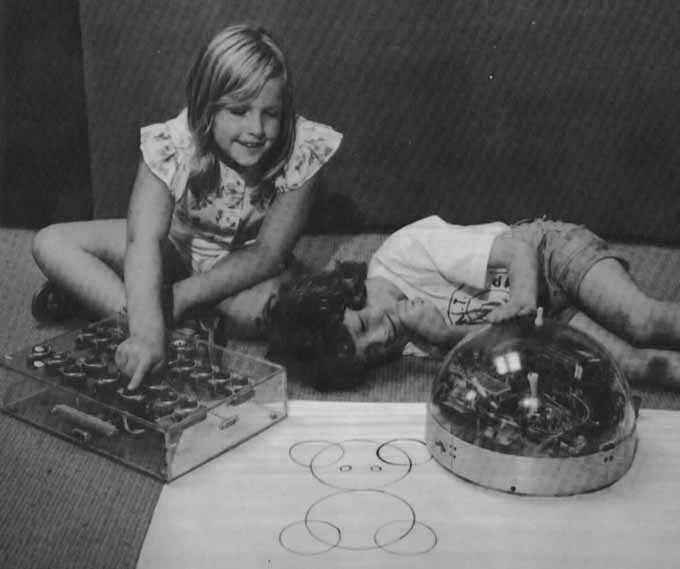
The LOGO environment written in LOGO had its physical embodiment. A good way to visualize and materialize the power of programming, especially for children.
In 1983, I was just born, and Papert taught children how to command cyber chaps
1972
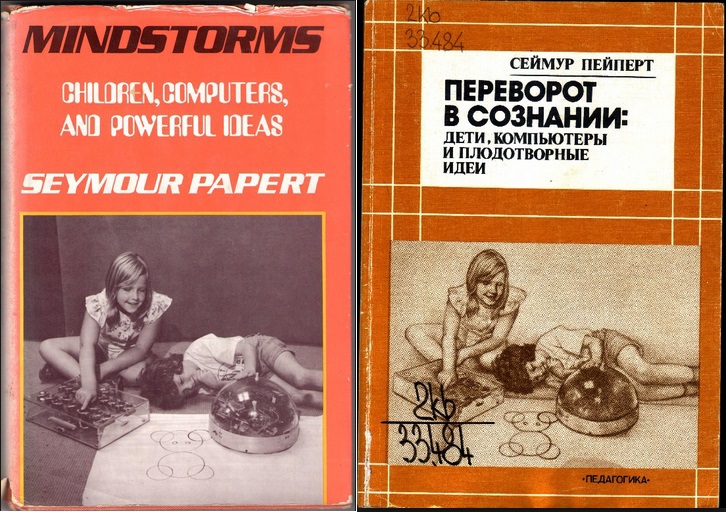
Written in 1980, published in Russian in 1989 (since then has not been reprinted). Read here , download here .
Lego borrowed the name for its controller:

An article in Wired about the origin of the name Lego Mindstorm
The book is very natural, from the life examples there is an explanation of structured programming, procedures, parallel processes, debugging, the margin of searching for errors, modularity. Papert shows how in education to move from the "philosophy of error" to the "philosophy of debugging."
I want to share some excerpts from the book:
“Using gears as models, I completely comprehended many abstract ideas. I especially remember two examples from the school course of mathematics. The multiplication table, which I imagined in the form of gears, and my first solution of equations with two unknowns (such as Zx + 4y = 10), immediately introduced myself as a differential gear. As soon as I presented a model of gears interconnected by the ratio of x to y, I was able to calculate how many teeth are required for each of the gears, and this equation became my good friend. ”
“The connection between programming style and walking on stilts is even more obvious in the case of Michael. And only through this similarity did Michael clearly understand the difference in his and Paul's approaches to mastering walking on stilts. In other words, the experience of programming has helped both boys to better understand the features of their own actions, to begin to treat themselves more intelligently. ”
“The basic idea of structured programming as a mathematical principle, as a means of learning, will become clearer from the following example, which describes the process of mastering another physical skill - juggling. This skill was not chosen by chance. Learning to draw a circle Turtles was a good reason to study mathematics "using your own body." Juggling is no less a good reason to study the movements of one’s own body “with the help of mathematics”. Of course, the picture revealed to us at the same time is more complex and interesting, since the work goes in both directions: from the metaphorical representation of body language through computational tools and vice versa. As they mastered the geometry of the Turtle, the children became more and more keenly aware of the meaning of the movements of their body, while at the same time they were mastering the formal geometry better. And the theoretical ideas of structured programming, when they were understood in connection with juggling, in connection with the real movements of body parts, received a new concrete embodiment, revealed new possibilities for their use. In both cases, the knowledge gained by the boys has a quality that we characterize as syntonic. "
From programming, the author is very cleverly moving to a worldview. As in writing the program, Paperper says, the child builds his picture of the world, then it is debugged and so many times.
About juggling for programmers recommended on Habré in 2011, a little offtopic about another "useful exercise for programmers."
Surely, anyone who reads Habr has arisen or will soon have a situation when they ask him: “What about phto-poglamming?”.
Seymour Papert's book is a great impulse to re-remember (and re-flare as it should) how we studied mathematics and programming, as well as to see how harmoniously you can explain diffs and programming, connecting unconscious and bodily metaphors, and to speculate how to make the world better if you build a normal education system.
Seymour Papert ends his book with the article "Mathematical Unconscious"
PS
Task:
Put 2 identical coins on the table. We will press one to the table, and the second we will roll on the rim of the first. The question is, how many turns (around its own center) will the second coin make in order to go around the first coin and return to its original position? (we exclude friction and sliding)
0 March. Seymour papert
March 1. Xerox alto
March 2, "Call Jake." NIC and RFC history
March 3, Grace "Grandma COBOL" Hopper
March 4 Margaret Hamilton: "Guys, I'll send you to the moon"
March 5, Hedy Lamarr. And in the movie naked to play and torpedo the bullet into the enemy
March 7 Gorgeous Six: girls who had a thermonuclear explosion calculated
March 8, "Video Games, I'm your father!"
Together with the company Edison we start the spring marathon of publications.
I will try to get to the primary sources of IT-technologies, to understand how they thought and what concepts were in the minds of the pioneers, what they dreamed about, how they saw the world of the future. Why did you think “computer”, “network”, “hypertext”, “intelligence amplifiers”, “collective problem solving system”, what meaning did they put into these concepts, what tools they wanted to achieve a result.
')
I hope that these materials will serve as an inspiration for those who are wondering how to go “from Zero to Unit” (to create something that had never happened before). I would like IT and “programming” to stop being just “coding for the sake of dough”, and recall that they were conceived as a lever to change the
Today celebrates its 22th birthday a man who was born in 1928 (88 astronomical years).
Seymour Papert is an outstanding mathematician, programmer, psychologist and teacher. One of the founders of the theory of artificial intelligence, the creator of Logo.

I have a rule. If something makes itself felt from three independent sources authoritative for me, then it is worth paying close attention to it.
The first time about Seymour Papert I heard a year ago in the hackspace from shamrin , he read his book in English and I was interested in his thoughts about juggling and programming, as well as the basic logical concepts formed in the brain of children.
A little later, I came to visit FISCHERTECHNIK , and I saw this book on the shelf, asked to read it for a month. I read avidly and realized that I had to buy the same for myself.
Half a year ago, I attended a presentation by David Yang , where he, responding to a question from the audience about whether his school has sponsors not from Armenia, mentioned Seymour Papert (it seems that only Jan and I in the audience knew who this was).
Today is the time to write about the author, about the book and about strong ideas. As well as explaining what has to do with juggling, stilts and slackline.
(and if you programmed on LOGO, then you will definitely be under the cat)
Seymour papert

Like Ilon Musk, he was born in Pretoria, in Africa.
He studied at the University of Cambridge from 1954 to 1958, at which time he participated in the activities of the Trotskyist circle around the revolutionary socialist publication Socialist Review.

In the early 1960s, Dr. Papert came to the Massachusetts Institute of Technology (MIT), where, together with Marvin Minsky, he founded the Artificial Intelligence Laboratory and in 1970 published his book Perceptrons in collaboration with him. In 1972, Minsky and Papert also wrote the book Artificial Intelligence.
At MIT, Papert created the Epistemology and Learning Research Group at the MIT Architecture Machine Group, which soon became the legendary MIT Media Lab. Here he developed a learning theory called constructionism based on the works of Jean Piaget , with whom Papert worked side by side from 1958 to 1963. Piaget responded: "No one understands my ideas as good as Papert."
In 1988, Papert was named LEGO-Professor of Educational Research, and a department was created specifically for him.
His educational activities have received numerous awards, including the Marconi International Award (for outstanding contributions to communication technology), an award from the Publishers Association for Mathematical Software, and the Smithsonian Computer World Award for leadership in learning.
Papert came to Russia several times, visited Moscow and St. Petersburg (for the first time in 2001 or in the early 1990s, the last time in May 2005), addressed teachers and administrators of educational institutions.
Ershov in his article “Programming - second literacy” refers to Papert.
Letter of Seymour Papert Yershov

LOGO and CyberCup
Logo (LOGO) is a high-level programming language developed in 1967 by Seymour Paperpt and Id Harel for educational purposes to teach preschool and primary school children the basic concepts of programming (recursion, extensibility, etc.). Logo also provides an environment in which children can develop their reasoning and problem solving skills. In essence, the logo language is an adaptation of the Lisp language (some even call it “Lisp without brackets”).
At the initiative of Papert, the so-called bug was used in the language, providing the connection “object - thought” (first a mechanical bug was crawling on the floor, and then its conventional image on the screen). As Papert noted, “the computer usually leads the child step by step,” and LOGO, on the contrary, “convinces the child that he is able to control the machine, allows the child to say:“ I am the master here ”.

The LOGO environment written in LOGO had its physical embodiment. A good way to visualize and materialize the power of programming, especially for children.
In 1983, I was just born, and Papert taught children how to command cyber chaps
1972
More videos of Papert
Book

Written in 1980, published in Russian in 1989 (since then has not been reprinted). Read here , download here .
Lego borrowed the name for its controller:

An article in Wired about the origin of the name Lego Mindstorm
The book is very natural, from the life examples there is an explanation of structured programming, procedures, parallel processes, debugging, the margin of searching for errors, modularity. Papert shows how in education to move from the "philosophy of error" to the "philosophy of debugging."
I want to share some excerpts from the book:
“Using gears as models, I completely comprehended many abstract ideas. I especially remember two examples from the school course of mathematics. The multiplication table, which I imagined in the form of gears, and my first solution of equations with two unknowns (such as Zx + 4y = 10), immediately introduced myself as a differential gear. As soon as I presented a model of gears interconnected by the ratio of x to y, I was able to calculate how many teeth are required for each of the gears, and this equation became my good friend. ”
My childhood gearboxes
I was not even two years old when I became interested in cars. The names of the car parts were an essential part of my vocabulary of those years. I was very proud of my knowledge of the parts of the transmission and gearbox, but my pride was my knowledge of the word "differential". Of course, the transmission mechanisms work, I realized much later, but as soon as this happened, the game with gears became my favorite activity. I was simply in love with round objects rotating like gears, and it is quite understandable that first of all I assembled from the "designer" the simplest gear system.
I learned to mentally represent spinning wheels and build causal chains of the type: “This wheel rotates like this, it means that it should rotate like this, and then ...”. I especially liked in such systems as differential gear that they did not observe a linear relationship, since the movement from the shaft to the wheel pair can be transmitted in various ways - depending on the resistance to be overcome by this pair. I remember my excitement quite clearly when I discovered that, without being strictly deterministic, the system can obey certain laws and be absolutely understandable.
I think that the fascination with differential gears had a greater impact on my mathematical development than what I was taught in elementary school. Using gears as models, I completely comprehended many abstract ideas. I especially remember two examples from the school course of mathematics. The multiplication table, which I imagined in the form of gears, and my first solution of equations with two unknowns (such as Zx + 4y = 10), immediately introduced myself as a differential gear. As soon as I presented a model of gears interconnected by the ratio of x to y, I was able to calculate how many teeth are required for each of the gears, and this equation became my good friend.
Many years later, when I read the works of Piaget, this incident served me as a model for his concept of assimilation, and I immediately noticed that Piaget’s reasoning was not in complete accordance with his own idea. Almost always he talks about the cognitive aspects of assimilation, although there is an affective sphere! Of course, the assimilation of equations using gears is a fruitful way of transferring learned knowledge to a new object. But such assimilation contains something more. I am sure that she helped me master the mathematics with a positive affective tone, which can be traced back to my childhood hobbies with cars. I think Piaget would agree with that. When I met him personally, I realized that his inattention to the affective sphere most likely stems from restraint, which is determined by the insufficiency of our knowledge about this sphere, than from the proud indifference. But let me go back to my childhood.
Once I was surprised to discover that some (and even many) adults do not understand gears or are simply indifferent to their magic. I myself have not thought too much about these mechanisms, but the question from which my discovery began did not cease to interest me: how could it be so simple for me to be incomprehensible to others? My proud father suggested “having a mind” as an explanation. But I was painfully aware that people who did not understand differential gear easily coped with things that I considered much more difficult. Gradually, I formulated what I still consider to be a fundamental fact of the teaching: any thing comes easy, if you manage to assimilate it into a set of your own models. When this does not work, then anything can be painfully difficult. It is from this that I, in my thoughts, took the path consonant with Piaget's reasoning. Understanding of the doctrine should be genetic, that is, it should be based on the genesis of knowledge. What an individual can learn and how he will learn depends on what models he has mastered. This, in turn, raises the question of how the individual learned his models. Consequently, in the “laws of teaching” it should be revealed how intellectual structures grow from one another, as in the course of this process they acquire not only a logical, but also an emotional form.
This book is an attempt to shift the focus of Piaget in applied genetic epistemology on the cognitive sphere in order to include the affective sphere in consideration. The book develops a new direction in pedagogical research, when attention is focused on creating conditions under which intellectual models can arise. That is what I have been doing for the last 20 years, often recalling some of the features of my acquaintance with differential gears. First, I remembered that no one told me to study these programs. Secondly, I remembered that my contact with the transmission mechanisms was filled with feeling, love, and not just understanding. Thirdly, I remembered that I first encountered these mechanisms in the second year of life. If then some “learned” pedagogical psychologist tried to measure the results of this collision, he would most likely fail. My collision with differential mechanisms had profound consequences, but they appeared, it seems to me, only many years later. Testing at two years of “before” and “after” collisions with these mechanisms would have done nothing.
Piaget's works set the conceptual framework that allowed me to take a fresh look at the gears of my childhood. These mechanisms can be used as an illustration of many fruitful "modern" mathematical ideas, such as group theory or the theory of relative motion. But the possibilities of their use are much wider. After all, with their help in the sensorimotor circuits of the child, a connection is established not only with formal knowledge, but also with knowledge of the physical world. Imagine yourself as a transmission mechanism, understand how it rotates, rotating with it. It is this kind of double bond — abstract and sensual — that allows, through transmission mechanisms, to attach consciousness to fruitful mathematics. According to the terminology developed in the subsequent chapters of this book, these mechanisms work in this case as a transitional object.
If Montessori lived to this day, then she, fascinated by my story, might have suggested developing a set of transmission mechanisms for children, so that each child could gain the same experience that I had. However, hoping for this would mean not understanding the very essence of my story. After all, I loved the gears! And this is something that cannot be described in purely cognitive terms. Something very personal has happened to me, and it cannot be said that the same things will happen again with other children.
So, my idea can be summarized as follows: what is beyond the power of transmission mechanisms, so a computer can handle. A computer is a technical Proteus. Its essence is in its universality, in its ability to imitate. Since it can take on thousands of faces and perform thousands of functions, it can satisfy thousands of tastes. This book is the result of the attempts I have made in the past 10 years to turn a computer into a tool so flexible that many children can create for themselves something similar to the gears of my childhood.
I learned to mentally represent spinning wheels and build causal chains of the type: “This wheel rotates like this, it means that it should rotate like this, and then ...”. I especially liked in such systems as differential gear that they did not observe a linear relationship, since the movement from the shaft to the wheel pair can be transmitted in various ways - depending on the resistance to be overcome by this pair. I remember my excitement quite clearly when I discovered that, without being strictly deterministic, the system can obey certain laws and be absolutely understandable.
I think that the fascination with differential gears had a greater impact on my mathematical development than what I was taught in elementary school. Using gears as models, I completely comprehended many abstract ideas. I especially remember two examples from the school course of mathematics. The multiplication table, which I imagined in the form of gears, and my first solution of equations with two unknowns (such as Zx + 4y = 10), immediately introduced myself as a differential gear. As soon as I presented a model of gears interconnected by the ratio of x to y, I was able to calculate how many teeth are required for each of the gears, and this equation became my good friend.
Many years later, when I read the works of Piaget, this incident served me as a model for his concept of assimilation, and I immediately noticed that Piaget’s reasoning was not in complete accordance with his own idea. Almost always he talks about the cognitive aspects of assimilation, although there is an affective sphere! Of course, the assimilation of equations using gears is a fruitful way of transferring learned knowledge to a new object. But such assimilation contains something more. I am sure that she helped me master the mathematics with a positive affective tone, which can be traced back to my childhood hobbies with cars. I think Piaget would agree with that. When I met him personally, I realized that his inattention to the affective sphere most likely stems from restraint, which is determined by the insufficiency of our knowledge about this sphere, than from the proud indifference. But let me go back to my childhood.
Once I was surprised to discover that some (and even many) adults do not understand gears or are simply indifferent to their magic. I myself have not thought too much about these mechanisms, but the question from which my discovery began did not cease to interest me: how could it be so simple for me to be incomprehensible to others? My proud father suggested “having a mind” as an explanation. But I was painfully aware that people who did not understand differential gear easily coped with things that I considered much more difficult. Gradually, I formulated what I still consider to be a fundamental fact of the teaching: any thing comes easy, if you manage to assimilate it into a set of your own models. When this does not work, then anything can be painfully difficult. It is from this that I, in my thoughts, took the path consonant with Piaget's reasoning. Understanding of the doctrine should be genetic, that is, it should be based on the genesis of knowledge. What an individual can learn and how he will learn depends on what models he has mastered. This, in turn, raises the question of how the individual learned his models. Consequently, in the “laws of teaching” it should be revealed how intellectual structures grow from one another, as in the course of this process they acquire not only a logical, but also an emotional form.
This book is an attempt to shift the focus of Piaget in applied genetic epistemology on the cognitive sphere in order to include the affective sphere in consideration. The book develops a new direction in pedagogical research, when attention is focused on creating conditions under which intellectual models can arise. That is what I have been doing for the last 20 years, often recalling some of the features of my acquaintance with differential gears. First, I remembered that no one told me to study these programs. Secondly, I remembered that my contact with the transmission mechanisms was filled with feeling, love, and not just understanding. Thirdly, I remembered that I first encountered these mechanisms in the second year of life. If then some “learned” pedagogical psychologist tried to measure the results of this collision, he would most likely fail. My collision with differential mechanisms had profound consequences, but they appeared, it seems to me, only many years later. Testing at two years of “before” and “after” collisions with these mechanisms would have done nothing.
Piaget's works set the conceptual framework that allowed me to take a fresh look at the gears of my childhood. These mechanisms can be used as an illustration of many fruitful "modern" mathematical ideas, such as group theory or the theory of relative motion. But the possibilities of their use are much wider. After all, with their help in the sensorimotor circuits of the child, a connection is established not only with formal knowledge, but also with knowledge of the physical world. Imagine yourself as a transmission mechanism, understand how it rotates, rotating with it. It is this kind of double bond — abstract and sensual — that allows, through transmission mechanisms, to attach consciousness to fruitful mathematics. According to the terminology developed in the subsequent chapters of this book, these mechanisms work in this case as a transitional object.
If Montessori lived to this day, then she, fascinated by my story, might have suggested developing a set of transmission mechanisms for children, so that each child could gain the same experience that I had. However, hoping for this would mean not understanding the very essence of my story. After all, I loved the gears! And this is something that cannot be described in purely cognitive terms. Something very personal has happened to me, and it cannot be said that the same things will happen again with other children.
So, my idea can be summarized as follows: what is beyond the power of transmission mechanisms, so a computer can handle. A computer is a technical Proteus. Its essence is in its universality, in its ability to imitate. Since it can take on thousands of faces and perform thousands of functions, it can satisfy thousands of tastes. This book is the result of the attempts I have made in the past 10 years to turn a computer into a tool so flexible that many children can create for themselves something similar to the gears of my childhood.
“The connection between programming style and walking on stilts is even more obvious in the case of Michael. And only through this similarity did Michael clearly understand the difference in his and Paul's approaches to mastering walking on stilts. In other words, the experience of programming has helped both boys to better understand the features of their own actions, to begin to treat themselves more intelligently. ”
Stilts
These two styles of planning and program development are ubiquitous. They can be traced when mastering both "physical" and "intellectual" skills. Consider, for example, the case of two fifth-graders who have studied programming and who have mastered physical skills in our laboratory teaching children.
Michael is a strong, athletic, “bully teenager” (this is how he characterizes himself). Paul is a more secretive, diligent, slightly slouching boy, Michael had a bad time at school, Paul is good, so no one was surprised when Paul began to quickly master programming, easily mastering such a complicated method as structured programming. After several weeks of work, Michael still wrote programs only in the “straight line” style. Without a doubt, this boy mastered all the necessary concepts to write more advanced programs, but he was hampered by classical and pronounced resistance to the use of procedures.
At this time, both boys began to learn to walk on stilts. Michael chose the following sequence of actions as a strategy: “The leg rests on the first stilt, the body rises, the second leg rests on the second stilt, the first leg on the stilts moves forward ...” over and over again, confident of his success, which he really achieved. But the surprise for both boys was that Paul was the first to master walking on stilts.
Paul's strategy was different. He started the same way as Michael, but when the boy saw that he wasn’t doing anything, he tried to isolate and correct those of his actions that caused his failure, an error. When you take a step forward, the stilt remains behind you. This is the mistake, but as soon as it is revealed, it is easy to fix it. One of the techniques is to invent such a step, when the stilt is in front of the foot, for this, the stilt should be raised along with the leg. The latter is achieved by raising the stilts with a hand that is on the other side of the foot, taking a step. The similarity with the style of programming of Paul made one assume that the boy “transferred” the techniques mastered in the first activity to the mastery of this physical skill.
Indeed, it is very likely that both situations are connected with the already established features of the general cognitive style of Paul. Experience with LOGO only allowed him to better understand these features. The relationship between programming style and walking on stilts is even more obvious in the case of Michael. And only through this similarity did Michael clearly understand the difference in his and Paul's approaches to mastering walking on stilts. In other words, the programming experience has helped both boys to better understand the features of their own actions, to begin to treat themselves more intelligently.
Michael is a strong, athletic, “bully teenager” (this is how he characterizes himself). Paul is a more secretive, diligent, slightly slouching boy, Michael had a bad time at school, Paul is good, so no one was surprised when Paul began to quickly master programming, easily mastering such a complicated method as structured programming. After several weeks of work, Michael still wrote programs only in the “straight line” style. Without a doubt, this boy mastered all the necessary concepts to write more advanced programs, but he was hampered by classical and pronounced resistance to the use of procedures.
At this time, both boys began to learn to walk on stilts. Michael chose the following sequence of actions as a strategy: “The leg rests on the first stilt, the body rises, the second leg rests on the second stilt, the first leg on the stilts moves forward ...” over and over again, confident of his success, which he really achieved. But the surprise for both boys was that Paul was the first to master walking on stilts.
Paul's strategy was different. He started the same way as Michael, but when the boy saw that he wasn’t doing anything, he tried to isolate and correct those of his actions that caused his failure, an error. When you take a step forward, the stilt remains behind you. This is the mistake, but as soon as it is revealed, it is easy to fix it. One of the techniques is to invent such a step, when the stilt is in front of the foot, for this, the stilt should be raised along with the leg. The latter is achieved by raising the stilts with a hand that is on the other side of the foot, taking a step. The similarity with the style of programming of Paul made one assume that the boy “transferred” the techniques mastered in the first activity to the mastery of this physical skill.
Indeed, it is very likely that both situations are connected with the already established features of the general cognitive style of Paul. Experience with LOGO only allowed him to better understand these features. The relationship between programming style and walking on stilts is even more obvious in the case of Michael. And only through this similarity did Michael clearly understand the difference in his and Paul's approaches to mastering walking on stilts. In other words, the programming experience has helped both boys to better understand the features of their own actions, to begin to treat themselves more intelligently.
“The basic idea of structured programming as a mathematical principle, as a means of learning, will become clearer from the following example, which describes the process of mastering another physical skill - juggling. This skill was not chosen by chance. Learning to draw a circle Turtles was a good reason to study mathematics "using your own body." Juggling is no less a good reason to study the movements of one’s own body “with the help of mathematics”. Of course, the picture revealed to us at the same time is more complex and interesting, since the work goes in both directions: from the metaphorical representation of body language through computational tools and vice versa. As they mastered the geometry of the Turtle, the children became more and more keenly aware of the meaning of the movements of their body, while at the same time they were mastering the formal geometry better. And the theoretical ideas of structured programming, when they were understood in connection with juggling, in connection with the real movements of body parts, received a new concrete embodiment, revealed new possibilities for their use. In both cases, the knowledge gained by the boys has a quality that we characterize as syntonic. "
Juggling
There are many different types of juggling. Most people associate juggling with the hands of flying objects. When circulating, the balls move in a “circle” one by one, flying up from the right hand, they are picked up by the left, then transferred to the right below and vice versa. There are two types of shots: a short, low flight of balls from one hand to the other at the bottom of the circle; a long, high flight of balls at the top of the circle.
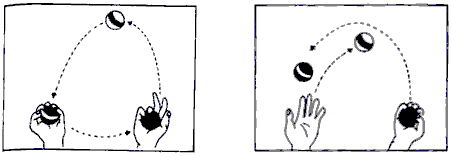
A type of juggling, called a cascade, has a simpler structure. The balls move in both directions along the upper arc, there is no movement along the lower part of the circle. Here there is only one type of throw - long and high (see Fig. 13). The simplicity of this movement allows us to better understand the juggling, and at the same time better understand our reasoning. The question that guides our reasoning is the following: can someone who wants to learn how to cascade juggling help or, on the contrary, prevent a verbal, analytical description of how to do this? Answer: depending on the circumstances. These circumstances are determined by the material on which the student performs an analytical description. We will use cascading juggling to show how good computer models can help build such “procedures” for people who improve their skills, and how understanding such “procedures” can help us learn programming and learn math. But, of course, certain verbal descriptions can be more embarrassing than helpful. Consider for example the following description:
1. Start. Balls 1 and 2 are in the left hand, the ball 3 - in the right.
2. We throw the ball 1 on a steep parabola in the right hand.
3. When the ball 1 reaches the top of the parabola, we throw the ball 3 from the left hand along the same steep parabola, but so that the trajectory of the ball 3 passes under the trajectory of the ball 1.
4. When the ball 1 reaches the right hand, and the ball 3 is at the top of the parabola, we throw the ball 2 along the trajectory passing below the ball's trajectory 3. And so on.
This description is essentially a primitive physical program of linear programming style. It is of little use for mastering the skill. People alien to computer culture may say that this description is very similar to a computer program, since here "one and only one instruction follows the other." This description is reminiscent of some programs, say the first program of Keith the PERSON (see Fig. 12b). But we have already seen that a simple chain of instructions without an internal, good-quality structure is not a good model for computer programming. We will also make sure that structured programming techniques are just what we need for writing programs and for mathematical descriptions of juggling.
Our goal - to develop a procedure for people juggling. As a first step, we identify and designate procedures by analogy with the procedures that Kate used in drawing the little man (DRAW WEDGE, DRAW A HEAD, DRAW A LINE). In the case of juggling the procedures that are self-evident - LEFT CAST and RIGHT CAST. Just as the WEDGE team functionally was due to the fact that the computer was required to portray some V-shaped figure on the screen, the CAND RING command causes the novice juggler to transfer what he holds in his right hand to his left.
But between programming a procedure we DRAW a MAN and programming a procedure JUNKING there is one important difference. The programmer of the first procedure may not care about how long it will take to implement, the programmer of the second procedure should take care of the time factor. The juggler must carry out the actions of throwing the right and throwing left at the appropriate moments of the juggling cycle, and these two actions only partially coincide in time. Since this means throwing the ball, these actions also include the stage of catching the ball: the RIGHT RIDE procedure also includes catching the ball when it approaches the left hand. Similarly, LEFT RESET means a team to throw the ball from left hand to right hand, grabbing it as soon as it gets close to 003.
Since most people are able to perform these actions, we will consider the LEFT CAST and RIGHT CAST initial and will focus on how to create a new procedure for these procedures, which we designated as JONGLING. Taken together, they differ in one significant respect from the combination of the WEDGE and HEAD procedures that make up the procedure. We DRAW A MAN. The LEFT CAST must occur before the action caused by the CAST RIGHT command ends. In the language of computer science, this is expressed as: we are dealing with parallel processes, as opposed to strictly sequential processes used in drawing man.
To describe this combination of procedures, we will introduce a new programming element: the concept of “DEMONS WHEN”. It is explained in the instruction: WHEN THE HUNGER IS. : , , , , . «» , , . , , , , . :
- :
- ,
- .

«-», , , .
, . 14. , , . , . 15 , , .
, , .
:
X X
, , , , , . , , - , ,
, ? , :
1) ,
2) , ,
3)
.
1. , . . , , . .
2. , . :
. , , .
3. ? , , 1. ( ) . , , .
4. . , , , . ( ) , . , . , - , .
5. . , , . , , — (. . 16).
2 , , 1 . . , . .
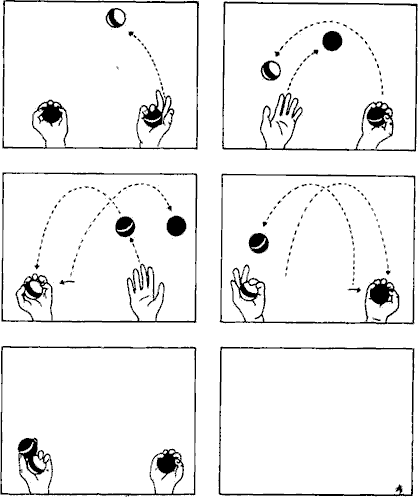
, , . , : , .
, . , . . , . , . , , .
, , , . (, , , ) , , , , . . , , , , . , ( ) . . , - , . , . , . . , .
, , , , , . , , , . , . , . , , 20—30 .
() , . , . . . . . , , , «» . . , .
, . , , «», «», «» . , — ; , . , . . , , , , , . «» .
. , , , , , . , . , .

A type of juggling, called a cascade, has a simpler structure. The balls move in both directions along the upper arc, there is no movement along the lower part of the circle. Here there is only one type of throw - long and high (see Fig. 13). The simplicity of this movement allows us to better understand the juggling, and at the same time better understand our reasoning. The question that guides our reasoning is the following: can someone who wants to learn how to cascade juggling help or, on the contrary, prevent a verbal, analytical description of how to do this? Answer: depending on the circumstances. These circumstances are determined by the material on which the student performs an analytical description. We will use cascading juggling to show how good computer models can help build such “procedures” for people who improve their skills, and how understanding such “procedures” can help us learn programming and learn math. But, of course, certain verbal descriptions can be more embarrassing than helpful. Consider for example the following description:
1. Start. Balls 1 and 2 are in the left hand, the ball 3 - in the right.
2. We throw the ball 1 on a steep parabola in the right hand.
3. When the ball 1 reaches the top of the parabola, we throw the ball 3 from the left hand along the same steep parabola, but so that the trajectory of the ball 3 passes under the trajectory of the ball 1.
4. When the ball 1 reaches the right hand, and the ball 3 is at the top of the parabola, we throw the ball 2 along the trajectory passing below the ball's trajectory 3. And so on.
This description is essentially a primitive physical program of linear programming style. It is of little use for mastering the skill. People alien to computer culture may say that this description is very similar to a computer program, since here "one and only one instruction follows the other." This description is reminiscent of some programs, say the first program of Keith the PERSON (see Fig. 12b). But we have already seen that a simple chain of instructions without an internal, good-quality structure is not a good model for computer programming. We will also make sure that structured programming techniques are just what we need for writing programs and for mathematical descriptions of juggling.
Our goal - to develop a procedure for people juggling. As a first step, we identify and designate procedures by analogy with the procedures that Kate used in drawing the little man (DRAW WEDGE, DRAW A HEAD, DRAW A LINE). In the case of juggling the procedures that are self-evident - LEFT CAST and RIGHT CAST. Just as the WEDGE team functionally was due to the fact that the computer was required to portray some V-shaped figure on the screen, the CAND RING command causes the novice juggler to transfer what he holds in his right hand to his left.
But between programming a procedure we DRAW a MAN and programming a procedure JUNKING there is one important difference. The programmer of the first procedure may not care about how long it will take to implement, the programmer of the second procedure should take care of the time factor. The juggler must carry out the actions of throwing the right and throwing left at the appropriate moments of the juggling cycle, and these two actions only partially coincide in time. Since this means throwing the ball, these actions also include the stage of catching the ball: the RIGHT RIDE procedure also includes catching the ball when it approaches the left hand. Similarly, LEFT RESET means a team to throw the ball from left hand to right hand, grabbing it as soon as it gets close to 003.
Since most people are able to perform these actions, we will consider the LEFT CAST and RIGHT CAST initial and will focus on how to create a new procedure for these procedures, which we designated as JONGLING. Taken together, they differ in one significant respect from the combination of the WEDGE and HEAD procedures that make up the procedure. We DRAW A MAN. The LEFT CAST must occur before the action caused by the CAST RIGHT command ends. In the language of computer science, this is expressed as: we are dealing with parallel processes, as opposed to strictly sequential processes used in drawing man.
To describe this combination of procedures, we will introduce a new programming element: the concept of “DEMONS WHEN”. It is explained in the instruction: WHEN THE HUNGER IS. : , , , , . «» , , . , , , , . :
- :
- ,
- .

«-», , , .
, . 14. , , . , . 15 , , .
, , .
:
X X
, , , , , . , , - , ,
, ? , :
1) ,
2) , ,
3)
.
1. , . . , , . .
2. , . :
. , , .
3. ? , , 1. ( ) . , , .
4. . , , , . ( ) , . , . , - , .
5. . , , . , , — (. . 16).
2 , , 1 . . , . .

, , . , : , .
, . , . . , . , . , , .
, , , . (, , , ) , , , , . . , , , , . , ( ) . . , - , . , . , . . , .
, , , , , . , , , . , . , . , , 20—30 .
() , . , . . . . . , , , «» . . , .
, . , , «», «», «» . , — ; , . , . . , , , , , . «» .
. , , , , , . , . , .
From programming, the author is very cleverly moving to a worldview. As in writing the program, Paperper says, the child builds his picture of the world, then it is debugged and so many times.
Slackline (a bit offtop)
About juggling for programmers recommended on Habré in 2011, a little offtopic about another "useful exercise for programmers."
one-dimensional trampoline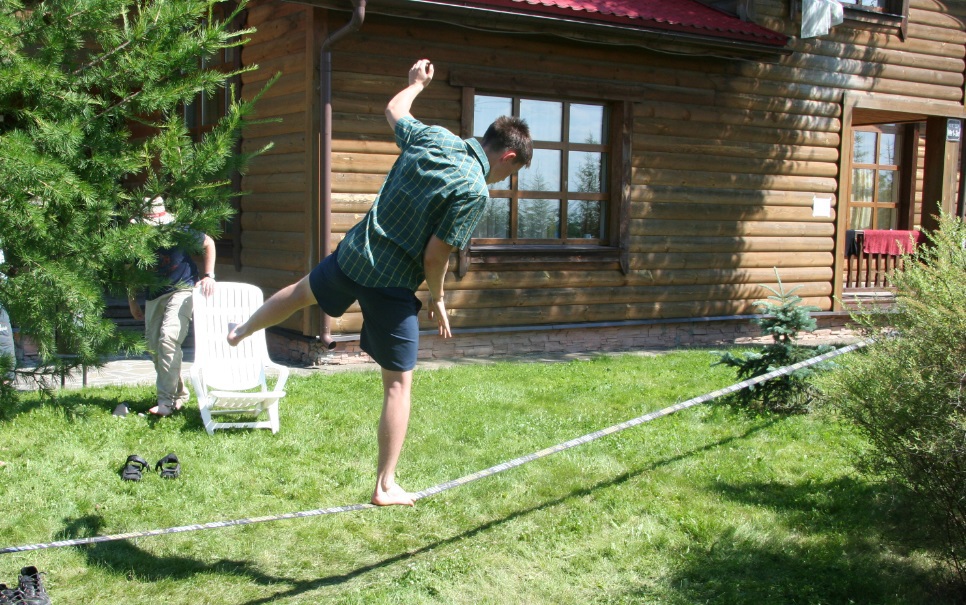
- . GoToCamp
, , , , . ( — , — . , — .)
( , ), -, 3-5 , .
:

.
15 ( )

www.russian-slackline.ru/slacklines/gibbon/gibbon-jibline
:
.

- . GoToCamp
, , , , . ( — , — . , — .)
( , ), -, 3-5 , .
:

.
15 ( )

www.russian-slackline.ru/slacklines/gibbon/gibbon-jibline
:
.
Conclusion
Surely, anyone who reads Habr has arisen or will soon have a situation when they ask him: “What about phto-poglamming?”.
Seymour Papert's book is a great impulse to re-remember (and re-flare as it should) how we studied mathematics and programming, as well as to see how harmoniously you can explain diffs and programming, connecting unconscious and bodily metaphors, and to speculate how to make the world better if you build a normal education system.
Seymour Papert ends his book with the article "Mathematical Unconscious"
"Neither mathematics nor man can be fully understood, being separated from each other."
PS
Task:
Put 2 identical coins on the table. We will press one to the table, and the second we will roll on the rim of the first. The question is, how many turns (around its own center) will the second coin make in order to go around the first coin and return to its original position? (we exclude friction and sliding)
0 March. Seymour papert
March 1. Xerox alto
March 2, "Call Jake." NIC and RFC history
March 3, Grace "Grandma COBOL" Hopper
March 4 Margaret Hamilton: "Guys, I'll send you to the moon"
March 5, Hedy Lamarr. And in the movie naked to play and torpedo the bullet into the enemy
March 7 Gorgeous Six: girls who had a thermonuclear explosion calculated
March 8, "Video Games, I'm your father!"
Source: https://habr.com/ru/post/277799/
All Articles